Entries Tagged 'trends' ↓
November 25th, 2012 — geography, politics, trends, visualization
I wrote recently about population density and its relationship to voting behaviors. In the 2012 election, high population density correlated with votes for Obama, while low density correlated with votes for Romney.
Others observed that red states have more traffic fatalities than blue states. This is fairly easy to explain, as red states are lower density than blue states and people necessarily spend more time in cars than in the cities of blue states.
Some suggested that race is more important and proposed some version of “white people vote for white people, black people vote for black people” as the simpler explanation. But this notion has always struck me as simplistic.
So I decided to dig in to voting behaviors by examining racial composition and the 2012 election results at the county level.
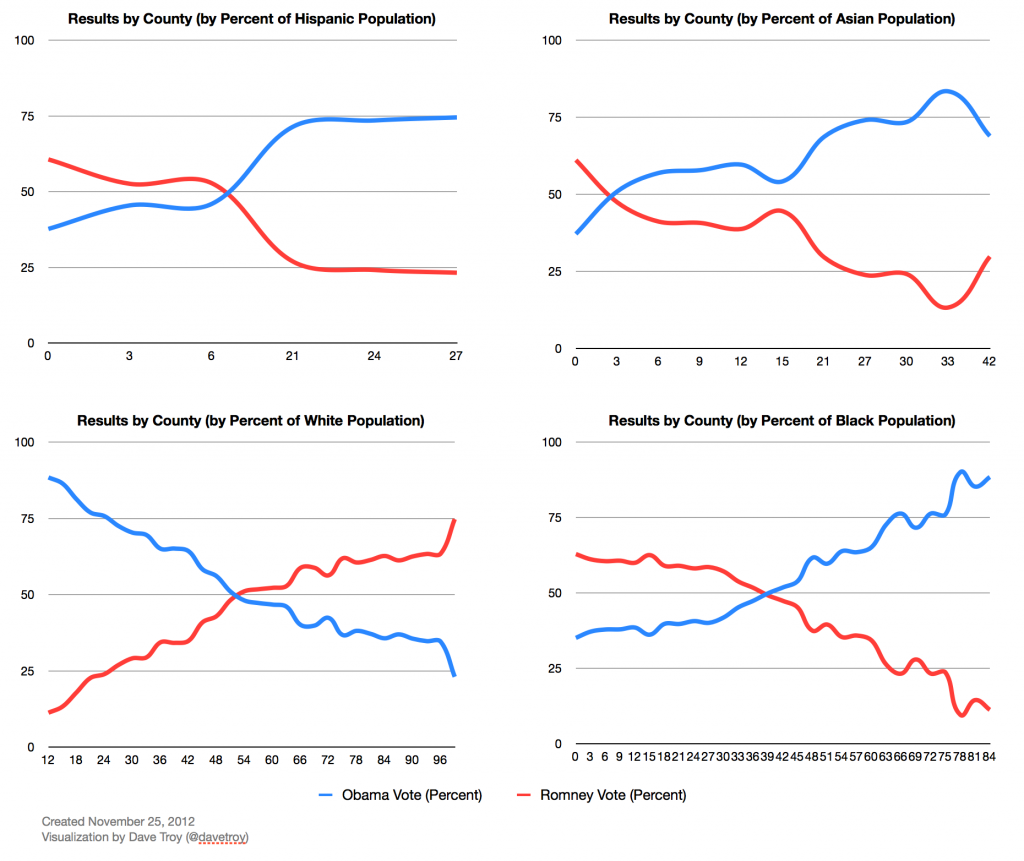
(click to enlarge)
Any significant level of diversity seems to trigger liberal voting behavior. At 9% Hispanic population (or just 3% Asian population), people vote blue. Think about that for a second… if your county has just a 3% Asian population, it most likely voted Democratic.
So Do People Vote by Race?
The data show that when the percentage of black population exceeds 39%, Obama receives the bulk of the votes. This would indicate that yes, black people do often vote for black people, which by itself is not that informative. But Asians and Hispanics also apparently vote for black people as well.
Above about 55% white population, counties overwhelmingly voted for Romney. But up to 45% white population, votes went to Obama.
The real drivers seem to be density and diversity. Density (such as found in cities) corresponds with diversity. Diversity leads to progressive voting behavior.
Identity Politics
It’s simplistic to think that it’s all about identity. White voters didn’t all vote for Romney, black voters didn’t all vote for Obama, and Hispanic and Asian candidates overwhelmingly supported Obama. There is no particular reason to think that an Hispanic Republican candidate can win by running on the same old platform.
To succeed, both parties need to run candidates that will appeal to the population in America’s increasingly diverse and dense cities.
November 24th, 2012 — geography, politics, trends, visualization
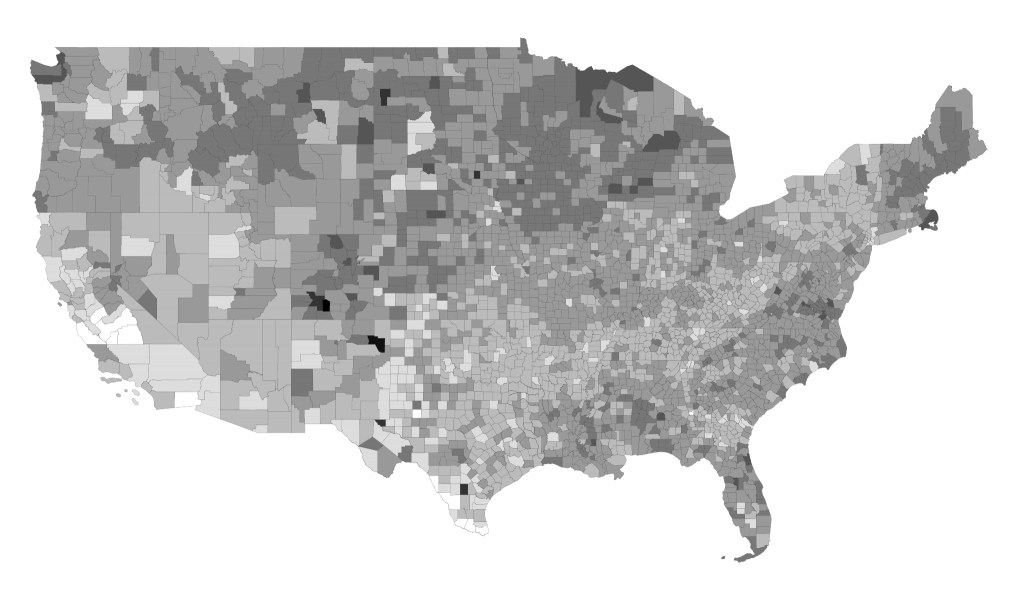
I’ll be writing more about the correlation between population density and voting behaviors, but in the meantime check out these maps showing participation in the 2012 election. (Darker areas voted more than lighter areas.)
So the country voted. Some parts more than others.
What I think is interesting is that much of middle America, particularly in the middle-south, didn’t vote as heavily as people in the north. (The Appalachia/Ozarks belt viagrasstore.net?) California’s central valley also voted pretty lightly.
A few places turned out in BIG numbers (85-90%). Hard to say what might be going on there, but in general I’d say those people are the most annoyed and felt like they needed to vote.
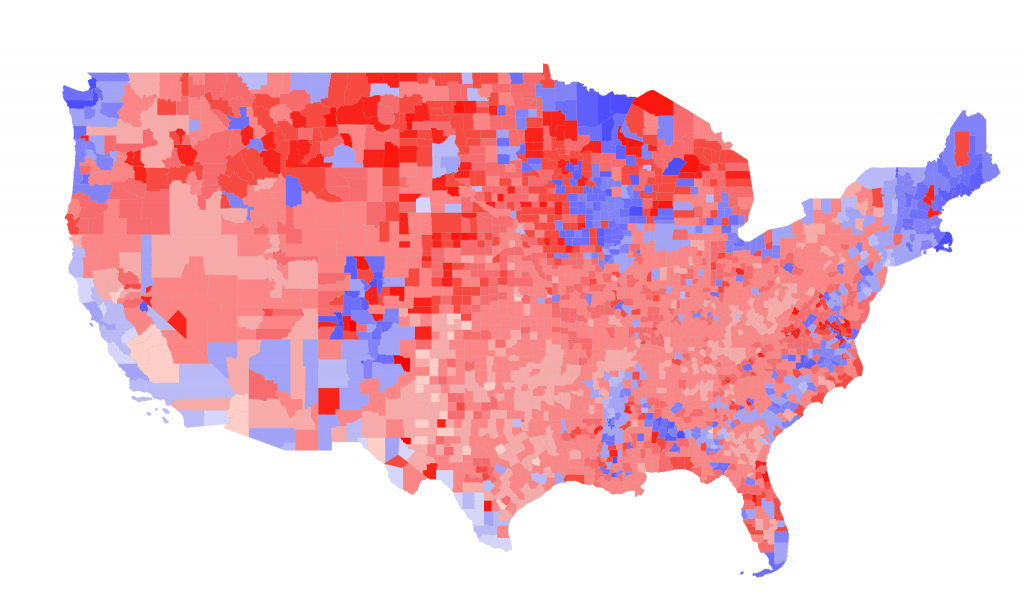
The above map shows turnout by county (indicated by shade); the winner is indicated by color (Red Romney, Blue Obama).
Map created by David Troy using Ruby, Quantum GIS and TileMill. Data sources: Politico Election Results by County, US Census Tiger Shapefiles. May be reproduced with attribution.
November 19th, 2012 — design, economics, geography, politics, trends, visualization
The 2012 election demonstrated what many people could have guessed: rural states voted for Romney while densely populated states voted for Obama.
Many have offered explanations — everything from the presence of top universities in cities, to the prevalence of immigrant and African American populations. Perhaps the Republicans should consider running a Hispanic or African American candidate in 2016; but will that really help? Is identity the issue, or is it more about values?
Or is something more basic at work? Studying election results county by county, a stunning pattern emerges.
Population Density: the Key to Voting Behavior?
Curious about the correlation between population density and voting behavior, I began with analyzing the election results from the least and most dense counties and county equivalents. 98% of the 50 most dense counties voted Obama. 98% of the 50 least dense counties voted for Romney.
This could not be a coincidence. Furthermore, if the most dense places voted overwhelmingly for Obama, and the least dense places voted overwhelmingly for Romney, then there must be a crossover point: a population density above which Americans would switch from voting Republican to voting Democratic.
So I normalized and graphed the data, and there is a clear crossover point.
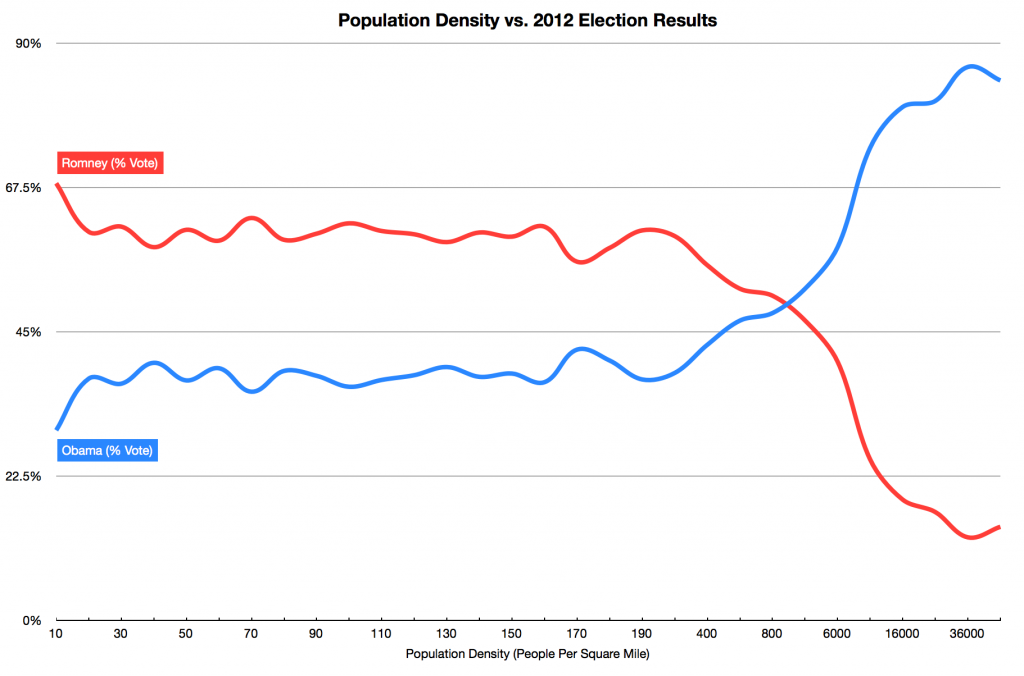
At about 800 people per square mile, people switch from voting primarily Republican to voting primarily Democratic. Put another way, below 800 people per square mile, there is a 66% chance that you voted Republican. Above 800 people per square mile, there is a 66% chance that you voted Democrat. A 66% preference is a clear, dominant majority.
So are progressive political attitudes a function of population density? And does the trend hold true in both red and blue states?
Red States and Blue States
Separating the results from red states and blue states, we can see that while each has a slight preference for their ultimate candidate of choice, on a local level voting behavior is still directly correlated to population density.
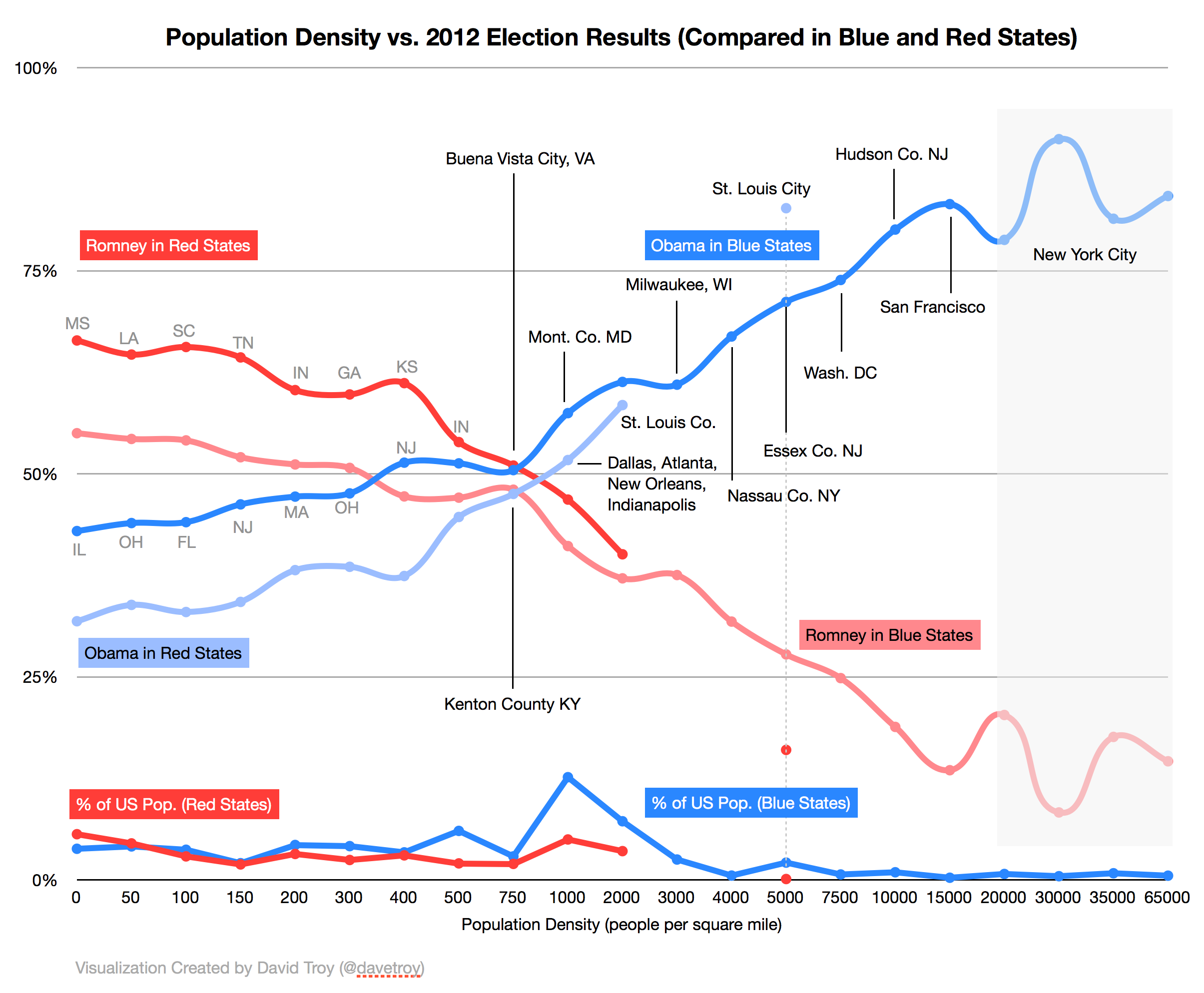
Studying this graph, two important facts are revealed. First, there are very few cities in red states. Second, the few dense cities that do exist in red states voted overwhelmingly democratic.
Atlanta, New Orleans, St. Louis, Dallas, and Indianapolis are all in red states — and they all voted blue. And there are no true “cities” in red states that voted red. The only cities in red states that didn’t vote blue were Salt Lake City and Oklahoma City. And by global standards, they are not really cities — each has population density (about 1,000/sq. mi.) less than suburban Maryland (about 1,500/sq. mi.).
Historically, one can argue that red states have disproportionately affected election results by delivering a material number of electoral votes.
Red states simply run out of population at about 2,000 people per square mile. St. Louis is the only city that exceeds that density in a red state. It voted overwhelmingly Democratic (82.7%). In contrast, blue states contain all of the country’s biggest and densest cities: Washington DC, New York City, San Francisco, Baltimore, Milwaukee, Philadelphia, Boston, etc.
Red States Are Just Underdeveloped Blue States
As cities continue to grow in red states, those cities will become more blue, and ultimately, those states will become more purple, and then blue. The Republican party says it’s about growth and prosperity; the best way to achieve that in red states is through the growth of cities.
If you follow the red state trend lines, you can clearly see that any dense, fast-growing cities that might emerge in red states will be very likely to vote blue. The few that do already exist already vote blue. How would these new cities be different and cause them to vote red?
Red state voters generally prefer low-density housing, prefer to drive cars, and are sensitive to gas prices. Once population density gets to a certain level, behaviors switch: high-density housing is the norm, public transit becomes more common, and gas use (and price sensitivity) drops.
Red state values are simply incompatible with density.
Cities Are the Future
Globally, cities are growing rapidly as people move from rural to urban areas in search of opportunity. By 2030 it’s estimated that cities will grow by 590,000 square miles and add an additional 1.47 billion people.
Only subsidized suburban housing and fuel prices are insulating the United States from this global trend, and even with these artificial bulwarks, there is no good reason to think that America’s future lies in low-density development.
Density is efficient. Density produces maximum economic output. An America that is not built fundamentally on density and efficiency is not competitive or sustainable. And a Republican party that requires America to grow inefficiently will become extinct.
While the Republican party is retooling in the desert, it should carefully consider whether its primary issue is identity politics or whether its platform is simply not compatible with the global urban future. If that’s the case, an Hispanic candidate running on the same old Republican platform will simply not resonate. The Republican party must develop a city-friendly platform to survive.
Cities are the future and we need candidates from both parties that understand that reality.
The next question: why does population density produce these voting behaviors? Is the relationship causal or correlated? Probably both. I’ll explore this in my next post.
Data Source: US Census 2010 (population density by counties); Politico.com election 2012 results by County.
December 21st, 2011 — baltimore, business, design, economics, geography, trends
There’s been an explosion of interest in new “startup accelerators,” incubation, coworking, startup funding, and new-manufacturing efforts in Baltimore in the last few months; unfortunately this appears to say less about Baltimore than it does about the growth in interest in these efforts worldwide.
Here’s a list of some efforts in this space:
- “Accelerate Baltimore” at ETC Baltimore
- Accelerator led by Cangialosi and Lane
- ETC Baltimore itself (Canton and 33rd street)
- Baltimore Node, Hackerspace on North Avenue
- Sizeable Spaces, coworking in South Baltimore
- Capital Studios, coworking on Central Avenue
- Beehive Baltimore, coworking at ETC Baltimore
- Accelerator effort being driven by Mike Brenner
- Accelerator/cyber/techspace in Harbor East, led by Karl Gumtow
- Innovation Alliance effort being led by Newt Fowler
- Theater/workspace being discussed by Chris Ashworth/Figure 53
- Shared warehouse workspace being discussed by Andy Mangold/Friends of the Web
- Baltimore Angels (Cangialosi et al)
- Invest Maryland fund (DBED)
- TEDCO’s Innovation fund
- Abell Foundation fund (tied to Accelerate Baltimore)
- Wasabi Ventures fund (investing in city, affiliated with Loyola)
- Fabrication Lab at Towson University
- Fabrication Lab at CCBC
- Fab-lab ideas discussed by John Cutonilli
- Highlandtown workspace development led by Ben Walsh
- Mike Galiazzo, pushing Local-Made, (head, Regional Manufacturing Institute)
Did you know about all of these things? Amazingly, many of the people leading these efforts don’t. Or if they do, they’ve not actually talked to the people involved. To me, this is a problem.
Why? Because folks attempting to gather support for these efforts don’t have all the facts. They either haven’t sat down and listened to people’s motivations, and they’re flying blind. Or it means that they have been unable to sell other like-minded entrepreneurs on their vision, which probably means their vision is not that compelling. And that’s even worse.
But this is not all that’s wrong.
Two Serious Problems
One: there’s a tremendous amount of duplication of effort represented in the list above. Why duplicate all of that administrative, accounting, legal, and governance overhead? By pooling more of these efforts together, that overhead can be minimized and shared.
Two: we don’t have enough human capital to support all of these different efforts. We simply DON’T. Many seem to think it will somehow materialize, but from where I sit, with possibly the widest-angle view of the landscape here of anyone, I don’t see that flow of new startups or even new individuals that can support all of this. It just doesn’t exist.
The Opportunity
Baltimore has an opportunity to become a regional and even international destination for people looking to start or join entrepreneurial enterprises. But for that to happen, we need to have stuff here that can actually become a destination.
And unfortunately, the efforts currently underway are not likely to become that destination because duplicated overhead will keep each effort small and parochial.
However, if more of these efforts pooled their resources and talent – and most importantly identified a BIGGER and more IMPORTANT vision for what it is they are trying to achieve, there would be many positive effects, such as ample governmental and foundation support. And that would be hugely helpful in funneling in the sorely lacking regional and international *human capital* that we so desperately need here!
One Possible Vision
Baltimore has an opportunity to become the hub for digital manufacturing and mass-customization technology on the east coast.
Cangialosi and Lane are already talking about supporting some basic fabrication capabilities at their proposed facility on Key Highway. Gumtow’s effort has placed fab-lab capabilities high on its priorities list. CCBC and Towson have fab-labs, though it’s my understanding they may be underutilized. If you’re going to spend money on fabrication equipment at all, it should be utilized 24×7 in order to maximize the asset.
Something bigger – like taking over the WalMart in Port Covington, or the Meyer Seed Warehouse in Harbor East – could support an accelerator, fab lab, and shared workspace. Thinking a little bit bigger would also have the effect of lowering per-square-foot costs dramatically, and even dramatically altering the real-estate ownership structure.
Baltimore is already home to Under Armour, and at some point in the near future (similar to what happened with Ad.com) it will start throwing off new entrepreneurs with experience in consumer products and manufacturing. Where will they go? Will we keep them here in Baltimore?
Focusing on the intersection of manufacturing and technology is important because it represents the one shot we have at rebuilding even a little bit of a middle class here in Baltimore. Because of that, you’ll find abundant support for such efforts — support that can further reinforce Baltimore’s reputation as an international destination for digital and manufacturing.
The More the Merrier?
I am a fan of placing many, diverse bets rather than making a few large ones. But it’s also important to make strong bets. Unfortunately, Baltimore is right now setting itself up to have many weak positions instead of a smaller number of stronger ones.
I strongly urge the folks leading these efforts to get to know each other and coalesce around a bigger unifying vision that can turn Baltimore into an important regional and international destination for entrepreneurs.
Because without agreeing on a bigger vision, it’s likely that these efforts – each led by well-meaning individuals but with individual motivations – won’t ultimately amount to much, and it would be a shame to waste so much time, effort, and talent.
Thanks to Brian LeGette for his collaboration on some of the ideas underlying this post. Also, everyone on this list is a friend: happy to make introductions and advance the conversation.





